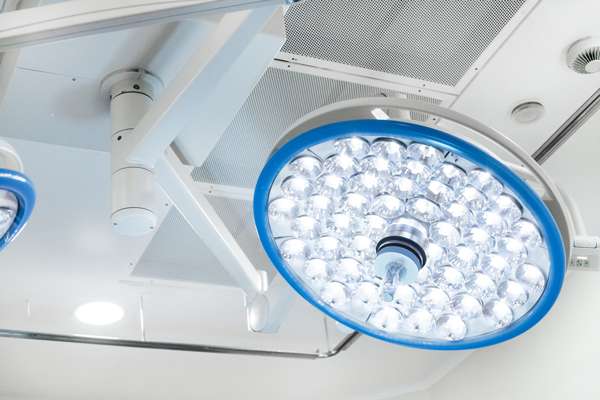
Surgical operations are inseparable from good lighting conditions. With the development of surgical technology, the most representative medical device is the surgical shadowless lamp.
Since the emergence of surgical shadowless lamps in the 1920s, surgical shadowless lamps have undergone many changes. Surgical shadowless lamps continue to meet the requirements of illumination (generally referring to light intensity), no shadows, temperature control, and color rendering required for surgery, and have become an indispensable and important part of modern operating rooms.The prototype of surgical shadowless lamp
In the middle of the 19th century, the wave of the industrial revolution swept across the world, and new things sprung up like mushrooms after rain, including surgical shadow removal technology.
At that time, people built the operating room in a southeast facing room with excellent lighting, and opened windows on the roof. But the biggest problem is that the operation time must be a sunny day, which is greatly affected by the weather. At the same time, the light is easily blocked by the doctor. By installing mirrors at the four corners of the ceiling of the operating room, using the mirror to reflect sunlight can make the light on the operating table brighter. adequate.
This simple idea is simple and practical, but due to the technical level and material limitations at that time, it was impossible to design a modern surgical shadowless lamp.
The world’s first shadowless lamp
In the 1920s, French professor Welland produced the earliest surgical shadowless lamp in the UK. He evenly placed many narrow flat mirrors on the dome of the shadowless lamp, and placed a 100-watt bulb at the center of the refractive lens. The emergence of surgical shadowless lamps got rid of the dilemma of surgeons looking at the sky to perform operations. Later, the principle and shape of shadowless lamps followed this method.
In the 1930s and 1940s, the shadowless lamp produced a second reform, and the single-lamp shadowless lamp in France and the track-type shadowless lamp in the United States appeared. The light source at that time was an incandescent light bulb. The maximum power of the light bulb could only reach 200W. The area around the filament was too large to control the light path and it was difficult to focus. The reflector was polished and formed of copper material, which was not easy to reflect.
The emergence of hole shadowless lamp
In the 1950s, in order to improve the illuminance of shadowless lamps, people began to increase the number of light sources of shadowless lamps, and the hole-type multi-lamp shadowless lamps were successively produced and used in Europe and Japan.
The hole-type multi-lamp shadowless lamp has 4 to 14 small reflective holes, and a 15W or 25W mirror bulb is placed in the center of each reflective hole, and the reflector is made of high-purity aluminum. The illuminance of the 9-hole shadowless lamp can reach 40,000 Lux (Lux).
Although the illuminance of the surgical shadowless lamp has increased, with the increase of the illuminance, the number of bulbs has increased, and the light temperature has increased. Even with a heat shield, it still causes discomfort to the doctor and dryness of the tissue at the surgical site, which affects postoperative recovery. .
The overall reflection shadowless lamp appears.
In the early 1980s, Japan began to produce cold light hole-type surgical shadowless lamps, which use optical systems and cold light reflectors to better control temperature rise. Using halogen light source, the illuminance of the shadowless lamp can reach more than 100,000 Lux (Lux).
In the late 1980s and early 1990s, with the continuous development of computer technology, the overall reflective surgical shadowless lamp came out. This shadowless light source uses halogen bulbs, and the reflective surface adopts CAD technology to design the curved surface of the reflector. The curved surface is formed by industrial stamping once to form a polygonal reflector. Many reflective surfaces overlap the light to form a homogeneous beam of light. Not only is this homogeneous beam as bright as daylight, but it also has no shadows and remains very uniform even when the light source is partially blocked by the surgeon’s shoulder or head.
Of course, this kind of lamp is not perfect, and its disadvantage is that its life is relatively short, and the bulb needs to be replaced frequently.
LED cold light shadowless lamp
In the 21st century, the advent of LED cold light shadowless lamps has brought new opportunities for the development of surgical shadowless lamps. In the 21st century, surgery involves more and more parts of the human body, more and more difficult operations, and the production of shadowless lamps is also paying more and more attention to detail performance. In addition to the improvement of basic performance parameters such as illuminance, shadowless intensity, temperature rise control, and color rendering, the uniformity of illuminance is also strictly required. In order to prevent the failure of the light source during the operation from causing a major impact on the operation, the surgical shadowless lamp adds a backup power supply. It can be switched automatically within 0.3 seconds; in order to facilitate the adjustment of the height and direction of the shadowless lamp, the surgical shadowless lamp adds a sterilizable central handle, which can steplessly adjust the size of the spot and the brightness of the light; in addition, with the requirements of telemedicine and teaching development, the surgical shadowless lamp increases In addition to the camera system, in addition to these points, the laminar heat dissipation design of the surgical shadowless lamp and the design of the multi-joint boom are also great highlights.
Compared with halogen lamps, as a cold light source, LEDs can significantly control temperature rise, have a higher utilization rate of light energy conversion, almost no heat radiation, and have a service life 60 times longer than halogen lamps, which can be described as economical and practical.
With the continuous emergence of new technologies and new materials, the future surgical shadowless lamp will have a further development even beyond our imagination.
In recent years, LED lights have been used in the field of surgical shadowless lamps, bringing new opportunities for the development of surgical shadowless lamps.
At present, the market share of LED surgical shadowless lamps in the domestic market is not very high. However, I believe that with the advantages of LED in terms of performance, as the technology becomes more mature and the production cost decreases, the LED surgical shadowless lamp must have a bright development prospect.

